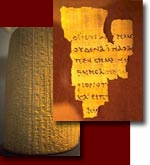| Site Map | Contacts | Links | Newsletter | |
Languages:
Hebrew
The basic Hebrew text is called the Masoretic Text (MT), which is named after a group of scribes in the ninth century that preserved the text and added vowels and punctuation marks. The original Hebrew just had consonants, but a few consonants functioned as vowels. No one would know how to pronounce the Hebrew words unless vowels marks were added. This is a great help in understanding the text. (Hebrew Bible)
There were three different tasks of copying the OT. The Sopherim wrote the consonantal text. The Nakdanim added the vowel points and accents. The Masoretes added the marginal notes. An example is the Kethib (what is written) and Qere (what should be read). There are over 1,300 of these. The vowels of the Qere were written in the text of the Kethib. There are three different systems of vowel pointing, the Babylonian, Palestinian and Tiberian which the Masoretes created. The marginal notes called Masora were mainly written in Aramaic and were like a concordance.
Before the discovery of the Dead Sea Scrolls the Nash Papyrus was the oldest known witness to the OT which dated to the first or second century AD. It contained the decalogue. The second oldest were the Cairo Geniza fragments (about 200,000) which date to the fifth century AD (See Princeton Geniza Project). Most of these are in the Cambridge University Library and the Bodleian Library at Oxford. Today the oldest known text of the OT was discovered in 1979 in tombs across the Hinnom valley from Jerusalem. The text is the benediction of Aaron (Numbers 6:24-26) written on a silver amulet from the 7th century BC (Hoerth 1998, 386).
The oldest surviving manuscript of the complete Bible is the Codex Leningradensis which dates to 1008 AD. A Facsimile edition of this great codex is now available (Leningrad Codex 1998, Eerdmans for $225). The BHS (Biblia Hebraica Stuttgartensia) follows this codex. The most comprehensive collection of old Hebrew manuscripts is in the Russian Public Library in St. Petersburg formerly called Leningrad. Another important text is the Aleppo Codex which is now in Jerusalem. The HUB (Hebrew University Bible) follows the Aleppo Codex. The Isaiah and Jeremiah editions are now available. For a more detailed study see The Text of the Old Testament by Ernst Wurthwein and Textual Criticism: Recovering the Text of the Hebrew Bible by P. Kyle McCarter, Jr.
Dead Sea Scrolls
The Dead Sea Scrolls (DSS) like the magnificent Isaiah scroll closely follow the MT, but there are a few exceptions. For example, Psalm 136 is an alphabetical psalm. Each verse begins with the next letter in the alphabet, but "N" is missing in the MT. In the DSS it is there, so somehow a scribe left this verse out. Another important difference is in I Samuel 10 where the MT is shortened. The Longer reading in the DSS explains what happens in this chapter.
Three of the most important Biblical texts from Qumran are: (1) The Isaiah Scroll from Cave 1 which has two different text types, with about 1,375 differences from the MT. (2) The Habakkuk Commentary from Cave 1 which uses the pesher method of interpretation, and the name Yahweh is written in paleo-Hebrew. (3) The Psalm scroll from Cave 11 contains 41 canonical psalms and 7 apocryphal psalms mixed in among them. The order of the psalms differs largely from the MT (Wurthwein 1979, 32).
Web sites about the Dead Sea Scrolls: West Semitic Research Project, Dead Sea Scrolls Project and Orion Center for the Study of the Dead Sea Scrolls (Hebrew University).
Samaritan Pentateuch
The Samaritan Pentateuch (SP), is an important witness to the Hebrew text. It is preserved in ancient Hebrew called "paleo-Hebrew," whereas the MT is in Aramaic block script. Some places differ from the MT especially where to worship, but when the SP agrees with the Septuagint it can be an important alternate reading. There are 1900 such instances (Wurthwein 1979, 43). The only striking difference in Genesis is the chronology in chapters 5 and 11.
The Samaritan Targum translates the Samaritan Pentateuch into Aramaic which can show us how they understood the text. There was no official recension of this targum so surviving manuscripts have their own text.
Online Course
Free Course in Biblical Hebrew (Click on the lessons in the upper left hand corner.) Complete this course for the 2 year Bible program. )
Online Study Tools
Old Testament Hebrew Lexicon
Key Links
- Free Online/Downloadable Hebrew Grammar Instruction
- Biblical Hebrew Grammar Summary
- MP3 Audio Hebrew Bible recordings
- Free Course in Biblical Hebrew
- The Online Hebrew Tutorial
- Introduction to Biblical Hebrew
- http://home.t-online.de/home/Mordechai-Pasternak/vuh1.htm
- The Tutorials Search Engine
- Hebrew Language
- Modern Hebrew
